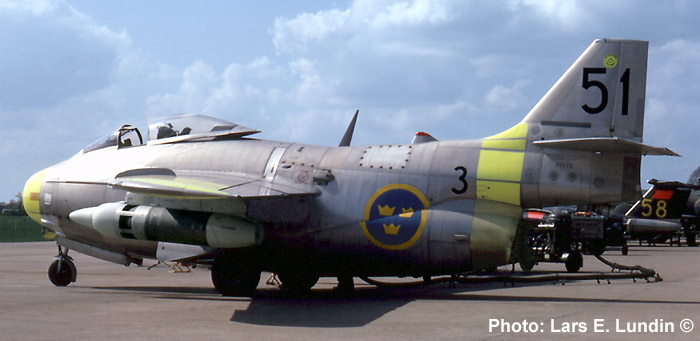|
|
||
|
J
29 - SAAB 29 ”Flygande tunnan” (1951-1976) |
||
|
|
Page 1 (3) |
|
|
|
||
 |
||
|
The
major problem for Swedish military aviation and Swedish aircraft
industry since the very beginning was the supply of good
aircraft engines. But after the end of WWII, the problem at last was
solved. License production of the British de Havilland Goblin was
secured and the engine was used in the first Swedish-built jet aircraft,
SAAB 21R. Most Goblin engines for the DH Vampire, an aircraft that was ordered by the Swedish Air Force in large quantities,
were to be manufactured here. Also the license for the successor
to the Goblin, the de Havilland Ghost engine was granted.
After
the end of the war, also Sweden had got access to epoch-making German
research reports concerning swept aircraft wings and their advantages at
high speed. To make a long story short, SAAB got the mission to develop
a new fighter aircraft for the Air Force. The aircraft was to be built
around the license-built Ghost engine (RM
2, 2.270 kp) and should have wings swept 25 degrees backwards. Due
to the large cross section of the engine, the fuselage became somewhat
round. The design from an early stage was nicknamed ”Flygande tunnan
(the Flying Barrel)”.
The
SAAB 29 was developed primarily as a fighter-interceptor aircraft, but
versions for reconnaissance and ground attack were also produced.
Unfortunately, no trainer version was produced due to the pressed
production programme. The very capable ”Tunnan” was difficult to
handle for inexperienced pilots. One third of the 661 SAAB 29s that were
built were lost in crashes. 99 pilots lost their lives.
The
”Tunnan” was manufactured as a fighter aircraft for the Swedish Air
Force in the following versions:
J
29A
- The first version in serial production. The first aircraft were
delivered to Wing F 13 at Norrköping in May of 1951. 224 aircraft were
built.
J 29B
-
An improved aircraft with better fuel capacity. 361 aircraft were
produced. In May of 1954, a J 29B broke the world speed record, flying
500 km at an average of 977 km/h. The earlier record was held by an
American F-86 Sabre.
J
29E
-
The most noticeably alteration was the ”saw-tooth” on each
wing. This permitted a higher Mach number. A large number of J 29B were
modified to J 29E standard.
J
29F
- The engine of the last version was fitted with an afterburner,
developed and built by Svenska Flygmotor AB. The engine with re-heath (RM
2B) increased the thrust to 2.800 kp. Most of the J 29Fs were
rebuilt J 29Es.
The
dependable J 29 got a long life in the Swedish Air Force. The last
mission as a combat aircraft
was flown in 1967, but a couple of ”Tunnans” were used as
target-tugs for a further nine years.
All
J 29s were armed with four 20 mm automatic cannons. Also rockets could
be carried. The J 29F was
equipped with air-to-air missiles type Sidewinder (Rb 24) in 1962-63.
Eventually, the ”Tunnan” got its real baptism of fire. Nine J 29Bs together with two S 29Cs (the photo reconnaissance version) were used by the Swedish UN forces in the Congo in the beginning of the sixties. It showed an outstanding serviceability even under these very different conditions. It also showed a good resistance to ground fire. One of the Congo aircraft (J 29B # 29398) is preserved and displayed at Flygvapenmuseum in the original UN markings. See photo (top).
One
preserved J 29F, # 29670, was restored to flying condition at Wing F 10
at Ängelholm and has appeared in airshows every year since 1995. It is
painted in the markings of F 10 as ”Yellow Rudolf”. |
|
|
|
For the Model Builder Several different plastic model kits of J 29 have been sold in the shops through the years. One example is the kit from Heller where the model builder could choose between two versions: J 29E code yellow H from Wing F 4 or S 29C code white B from the Swedish UN forces in Congo (F 22). Scale 1:72, catalouge number 260. |
|
|
|
|
||
 |
||
| # 29575 as target tug. Note the winch under the wing. F 3, Malmen, May 1972. | ||
|
|
|
|
|
|
||
|
|
||
|
© Lars Henriksson |
|
Updated 2010-02-14 |
|
Custom Search
|
||
